One day I set out to research the origins of today’s Western cuisine, expecting a long drawn out ordeal. But no, after 5 or 10 minutes on line I learned that the inspiration for much of what we eat these days in the U.S. is attributed however remotely to a noble party-loving gentleman who lived in ancient Rome. Apicius by name. He had a nick name – “Peachy.”
Apicius is associated with what is considered the authoritative cookbook of its time – appropriately titled “Apicius”, a copy of which I have managed to acquire via Amazon.com from that portion of the Roman Archives not destroyed by the fire that Nero started.
The fact is, though, Signor Apicius had not the slightest connection with the ponderous volume bearing his name. It was apparently named posthumously in his honor by subsequent unknown Roman authors who had recollections of his love of food and drink (mostly drink I bet). They simply copied down the recipes for his favorite goodies and gave him all due credit hoping that name recognition would boost sales.
So among other things this explains how one of the most prestigious cooking schools in Italy, affiliated with the University of Florence, is named “Apicius School of Culinary Arts”. I had the pleasure of attending an extended course of study at this institution recently. But to no one’s surprise not a single dish we prepared had the slightest connection to any items on Apicius’ fave list.
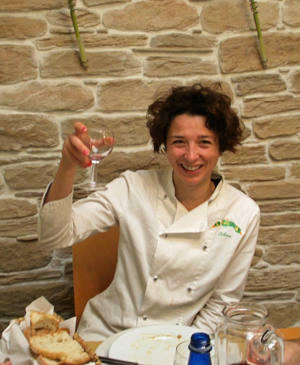 Instead the school focused for days on end on the cuisine of Tuscany with occasional detours to the other regions of Italy. Of the approximately 45 dishes we created under the superb direction of Chef Silvia (pictured left) one stuck with me as I traveled back from Florence to the real world here in Bishopville, Maryland. The recipe I wanted to perfect once back at home is none other than Biscotti!
Instead the school focused for days on end on the cuisine of Tuscany with occasional detours to the other regions of Italy. Of the approximately 45 dishes we created under the superb direction of Chef Silvia (pictured left) one stuck with me as I traveled back from Florence to the real world here in Bishopville, Maryland. The recipe I wanted to perfect once back at home is none other than Biscotti!
I settled on to the biscotti recipe for a number of reasons among which (1) I don’t have baking skills and need more experience, (2) biscotti are hard to screw up, (3) they last for months on end in a big glass jar and (4) they can be thrown in with any breakfast, lunch, snack or dinner menu you can imagine. I mean you can serve them at Hawaiian luaus even. They’re also great for teething babies!
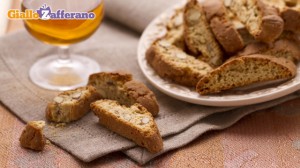 So herewith the Apicius School’s recipe for Tuscan biscotti, better known in the region as Biscotti di Prato, referring to the town where they were first prepared. Apicius himself never tasted them but no doubt he would approve.
So herewith the Apicius School’s recipe for Tuscan biscotti, better known in the region as Biscotti di Prato, referring to the town where they were first prepared. Apicius himself never tasted them but no doubt he would approve.
Biscotti di Prato
Serves 12
- 2 cups all purpose flour
- 1 cup sugar
- 1 cup almonds (preferably salted or lightly salted)
- 3 eggs + one egg yolk
- 2 tsp. vanilla extract
- 1 tsp. baking powder
- 1 tsp. salt
Preheat oven to 350 degrees F. In a large bowl combine flour, sugar, almonds, baking powder, vanilla, salt, eggs and yolk. Unfortunately bare hands are the only effective tools for this step. Set mixed dough on a floured pastry board and separate into two baguette-shaped loaves. Transfer to cookie sheet lined with oven paper. Bake for 15 minutes. Remove from the oven. When cooled cut loaves diagonally into 3/4 inch slices. Return to the oven and bake again until lightly browned all over, turning over as necessary to achieve even color.
Save one slice for Apicius should he unexpectedly show up at your door. He’ll be wearing his favorite toga.

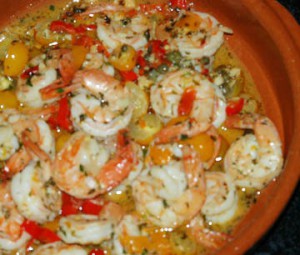 Posting this particular recipe not only highlights one of the tastiest entrees ever to emerge strictly by accident from my kitchen, but also provides pretext for calling attention to one of the most widely-spoken mispronunciations in all recorded history.
Posting this particular recipe not only highlights one of the tastiest entrees ever to emerge strictly by accident from my kitchen, but also provides pretext for calling attention to one of the most widely-spoken mispronunciations in all recorded history.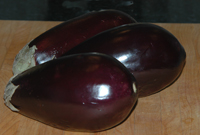 How is it that the eggplant, a vegetable grown since before recorded history and consumed today around the clock like pasta and pizza, still fires up controversy? You’d think we all would be on the same page by now. Or maybe I’m the only one off the page with the rest of the world. I’ll explain.
How is it that the eggplant, a vegetable grown since before recorded history and consumed today around the clock like pasta and pizza, still fires up controversy? You’d think we all would be on the same page by now. Or maybe I’m the only one off the page with the rest of the world. I’ll explain.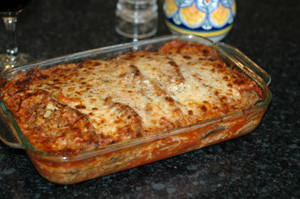 Now the challenge. I propose to make eggplant parmesan with the same recipe except for one variation, one with the salting business and one without. I then propose to seat my committee of Sicilians at the table and defy them to identify which version was salted and drained and which was not. One Thousand Euro to the team if they get it right. Any Sicilians in the audience wanna step up?
Now the challenge. I propose to make eggplant parmesan with the same recipe except for one variation, one with the salting business and one without. I then propose to seat my committee of Sicilians at the table and defy them to identify which version was salted and drained and which was not. One Thousand Euro to the team if they get it right. Any Sicilians in the audience wanna step up?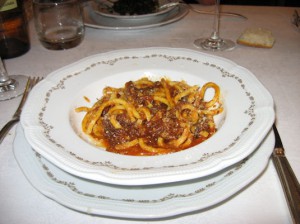
 Inevitably we come around to the No. 1 staple dish for all Italians and Italian-Americans, not to mention a few million Brazilians and Argentinians whose Italian ancestors boarded boats for the U.S. that ran off course.
Inevitably we come around to the No. 1 staple dish for all Italians and Italian-Americans, not to mention a few million Brazilians and Argentinians whose Italian ancestors boarded boats for the U.S. that ran off course.